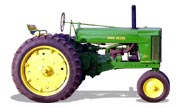Hi,
The older machines, like my 'M' were spec'd to use non-detergent motor oil. One can use up to 30ND in those.
But, that's in the summer. In the cooler weather, one has to drain the 30 wt out and replace it with 20 or 10 wt. If you leave the 30 wt in and the temp drops below 40 deg F, then the lift becomes really slow to operate. As it gets colder, it won't work at all eventually.
Also, you need to run non-detergent motor oil. If it's got the soap in it, which is to clean out combustion byproducts in an engine, the stuff will foam during use and wind up preventing the lift from operating at rated load, or even stop it completely as the soap bubbles cause cavitation in the pump....
So, now the question is: where do you get 20 wt or 10 wt ND motor oil these days? You can get it, but you have to go to the oil dealer (the guys with the big tanks and trucks that sell only oil) and ask for it. They probably don't stock it, but they can order it from the oil companies that specialize in lubricants.
The end result is that you're going to pay 2-3x the cost of going to the John Deere dealer and buying HyGard. You can get hyd oil even cheaper in the farm stores, of course. Deere is always dear, you know!

So, in the end, tell me why you want to go back in time and use non detergent motor oil in the older iron?
Oh, and by the time even the 420 had come out, they had come up with specialized light weight hydraulic fluid that could handle the pressure whilst remaining thin and so one no longer needed to change the hyd oil with the seasons. Plus, hyd fluid has additives to prevent foaming and also to prevent oxidation and also to give a longer service life between changes.
So, tell me again *why* you want to go back in time and use an inferior oil you have to change twice each year??

Maybe if you happen to have some surplus drums of 10, 20 and 30 wt ND motor oil around and just want to use it for something before you haul it to the oil recycling center?

As was already pointed out, lubrication engineering is an exact science that combines both chemical and mechanical engineering. Those boys figured all this out a long time ago, and they never stop trying to make lubricants even better.

later!
Stan






